Cytopathogenesis of Vesicular Stomatitis Virus Is Regulated by the PSAP Motif of M Protein in a Species-Dependent Manner
Abstract
:1. Introduction
2. Results
2.1. VSV Recombinant PS > A4 Is Attenuated in Mice
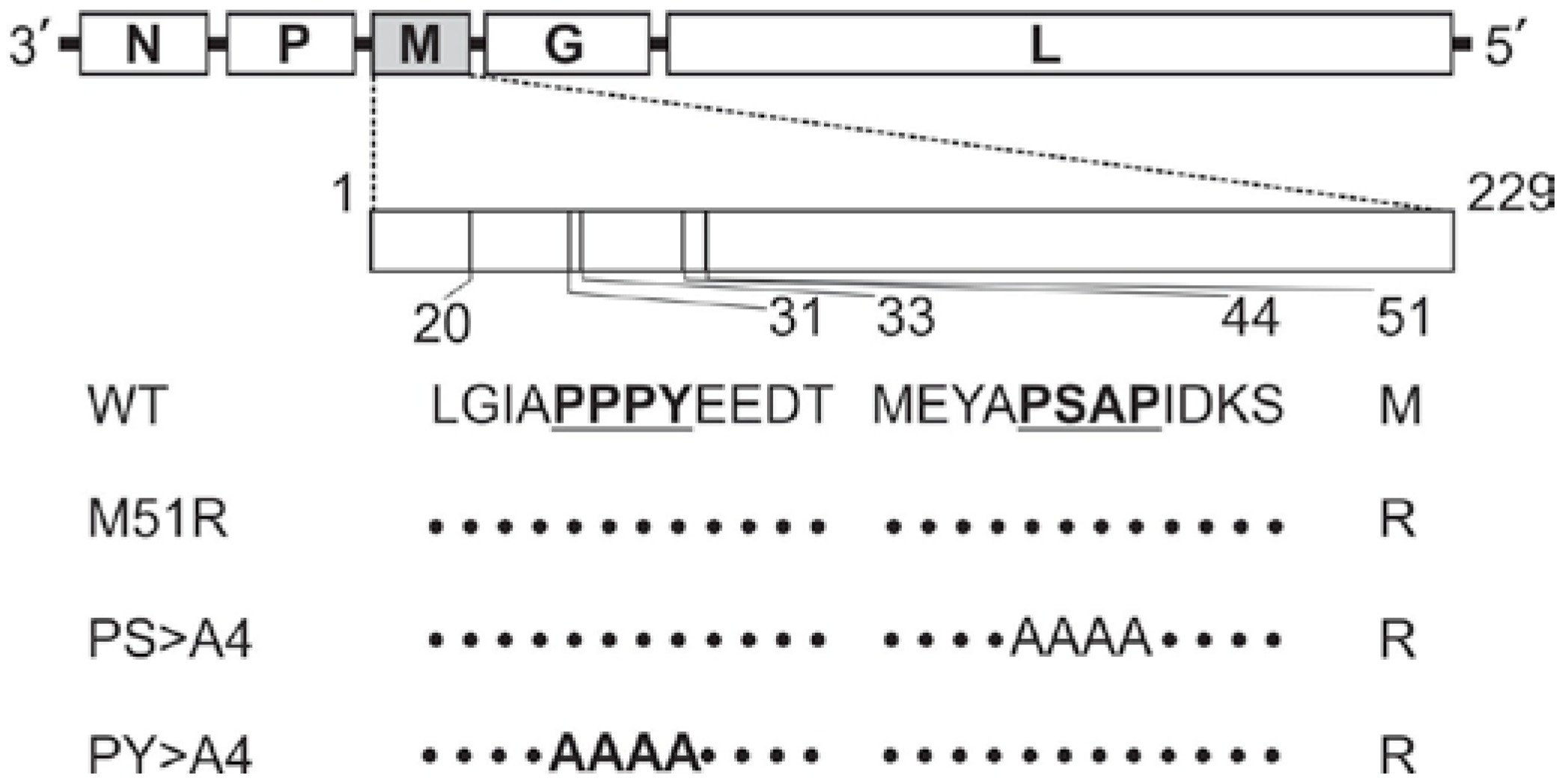
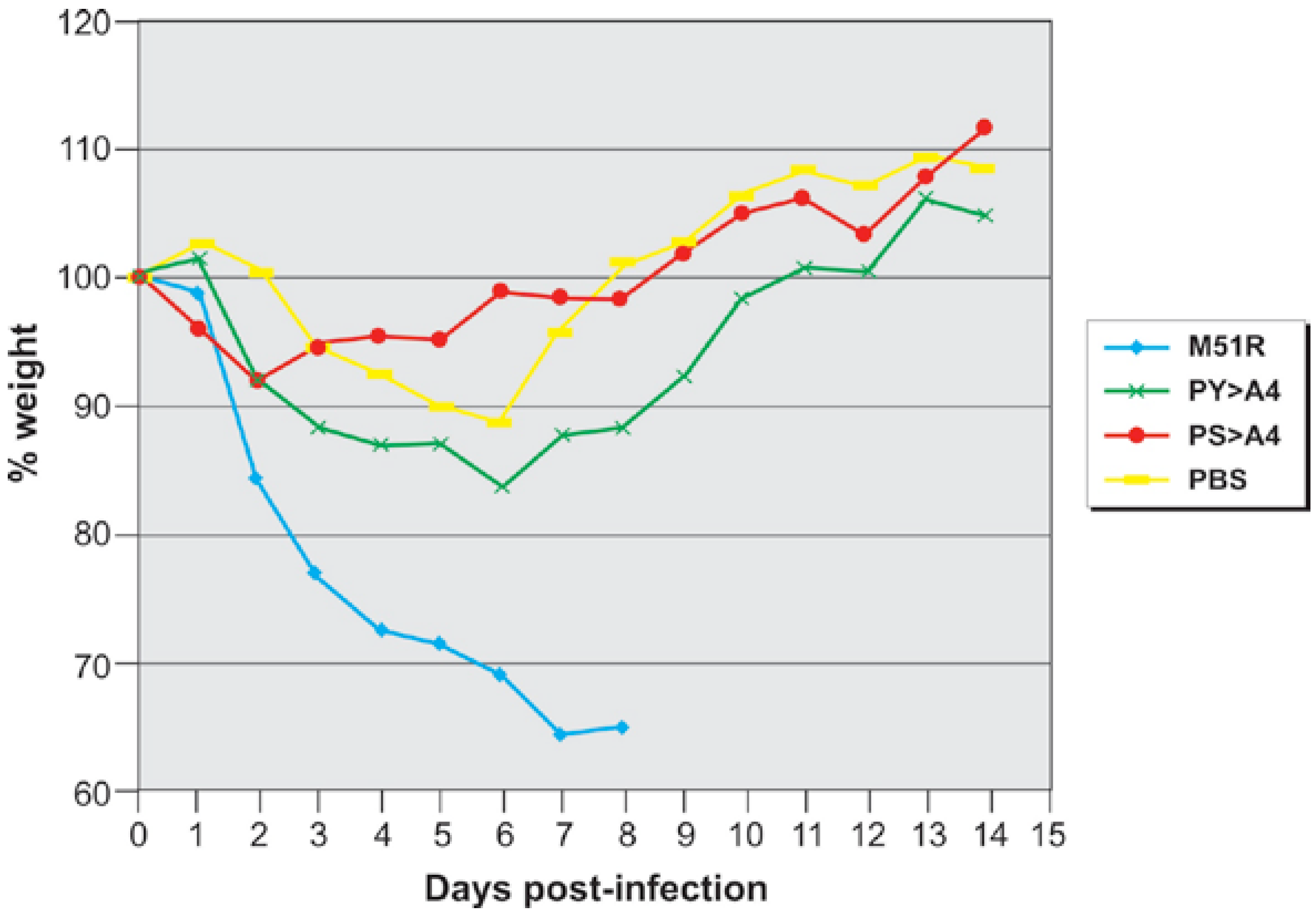
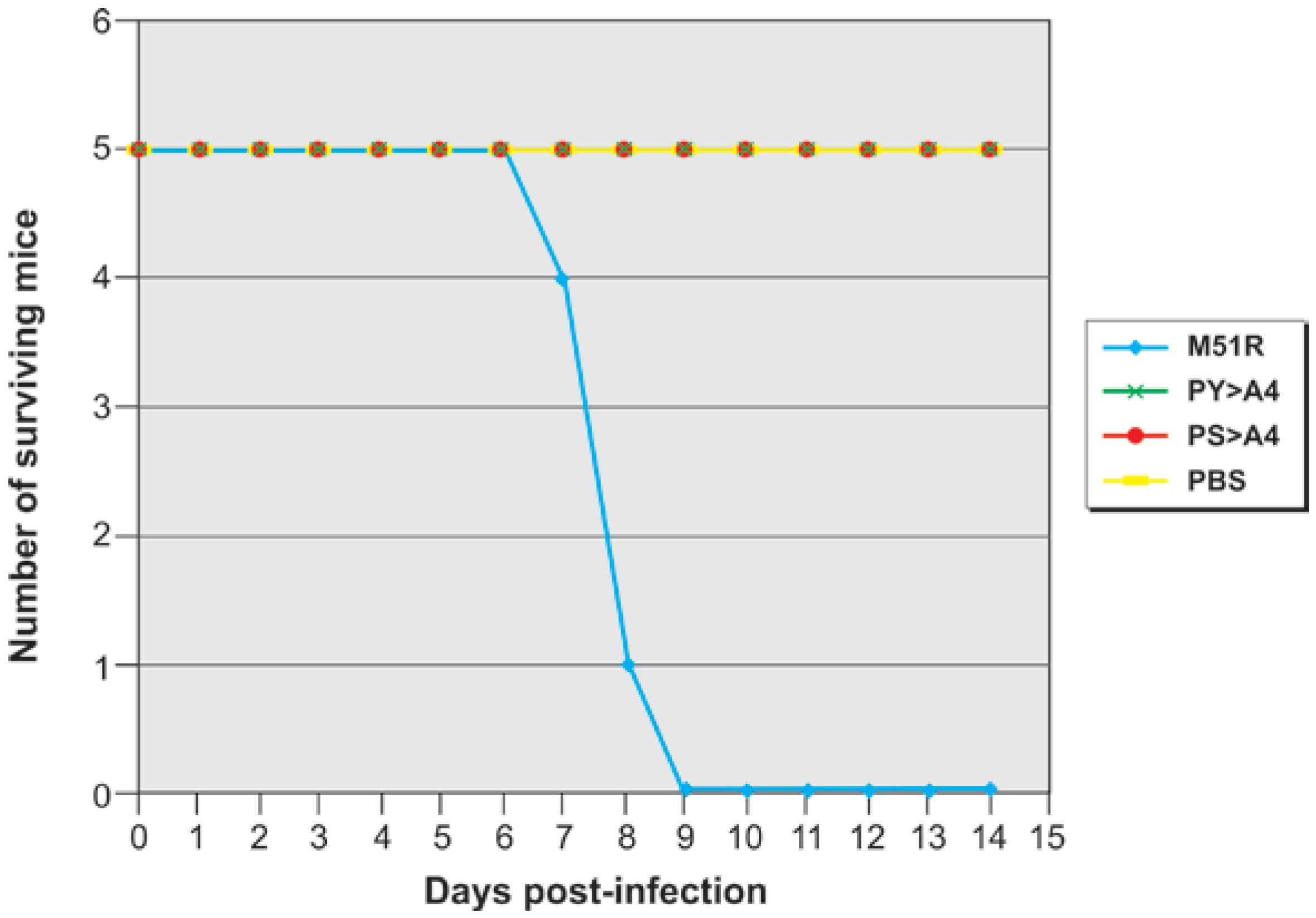

2.2. VSV Recombinant PS > A4 Is Pathogenic in Insect Cells
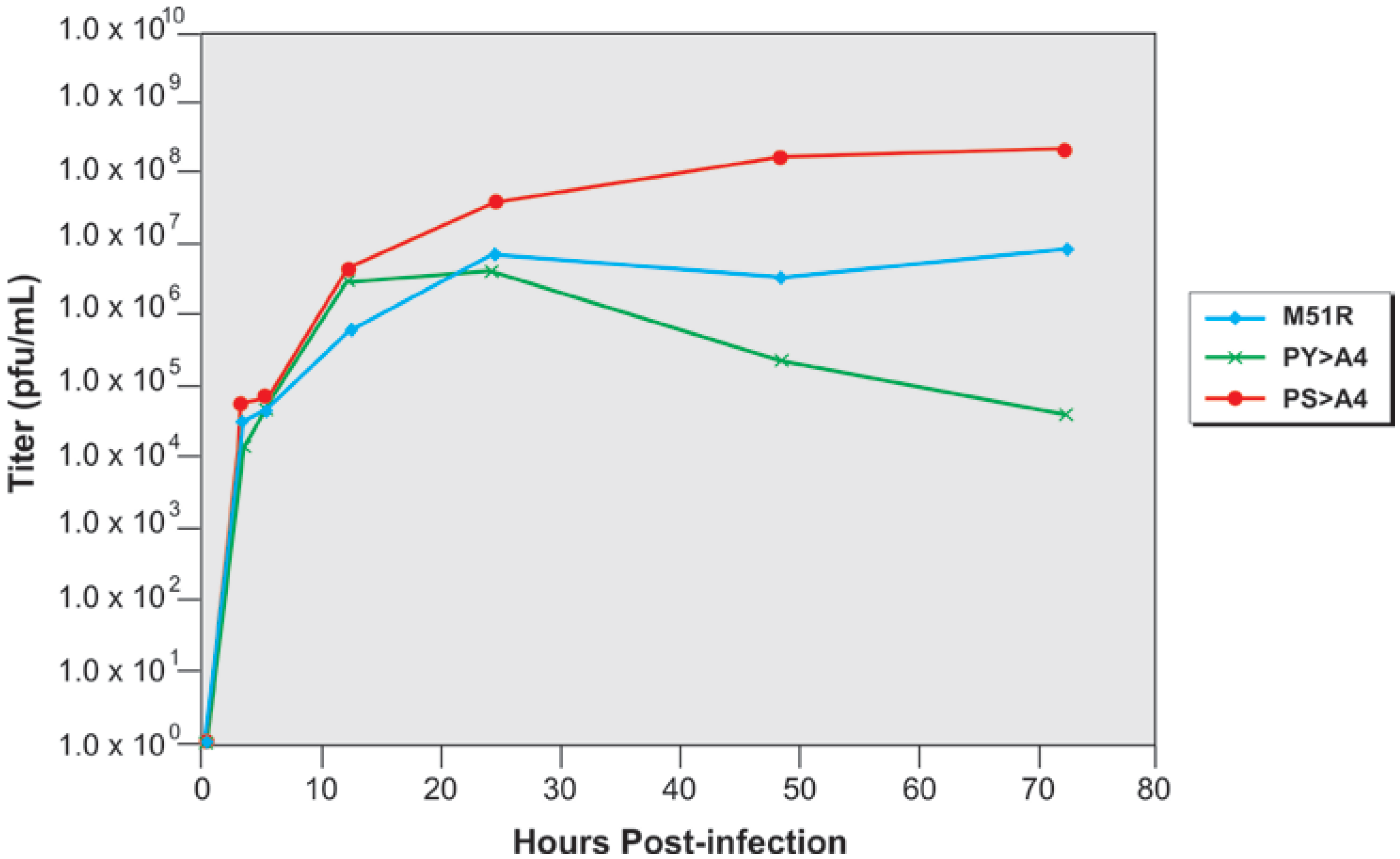
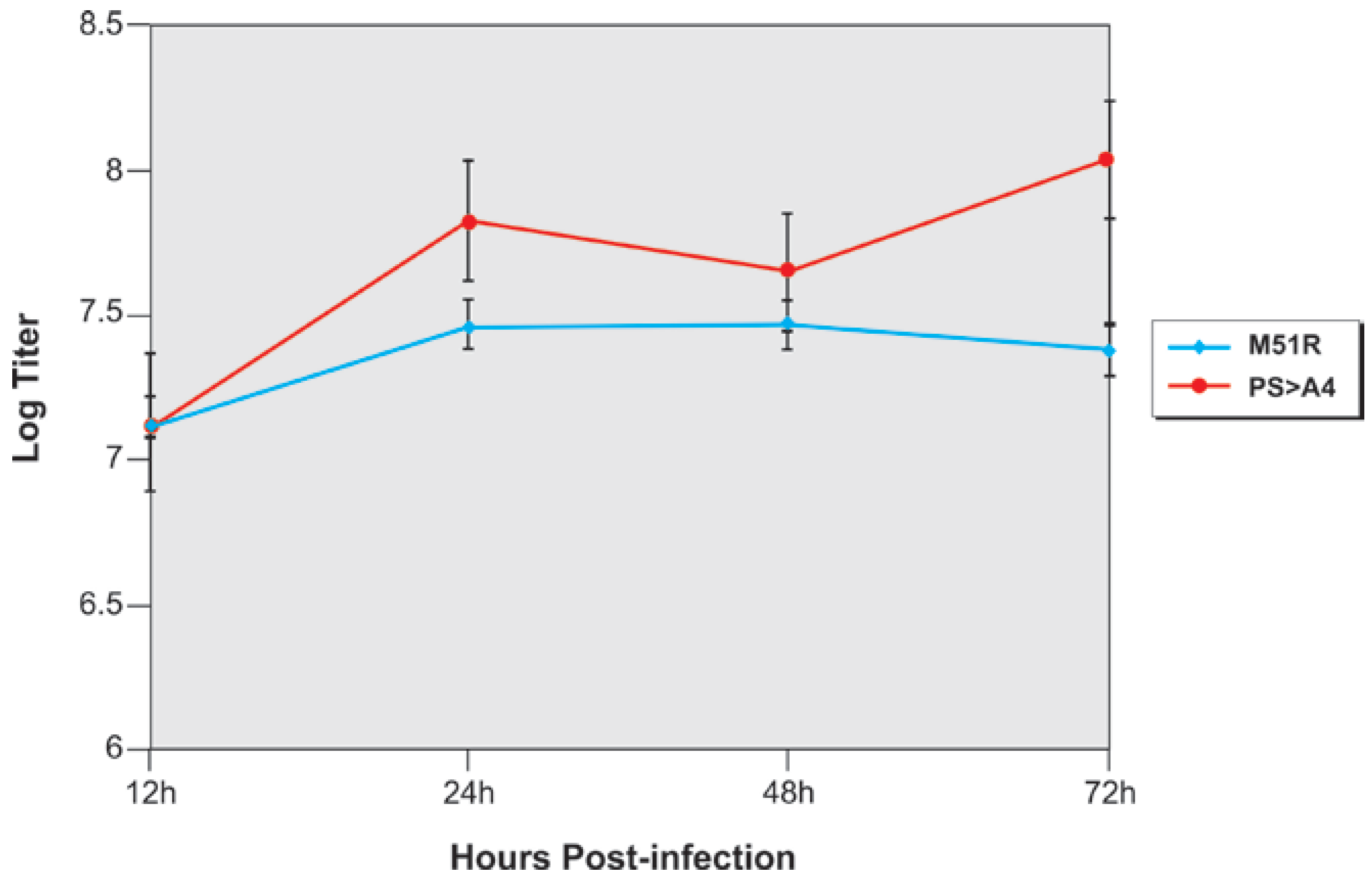
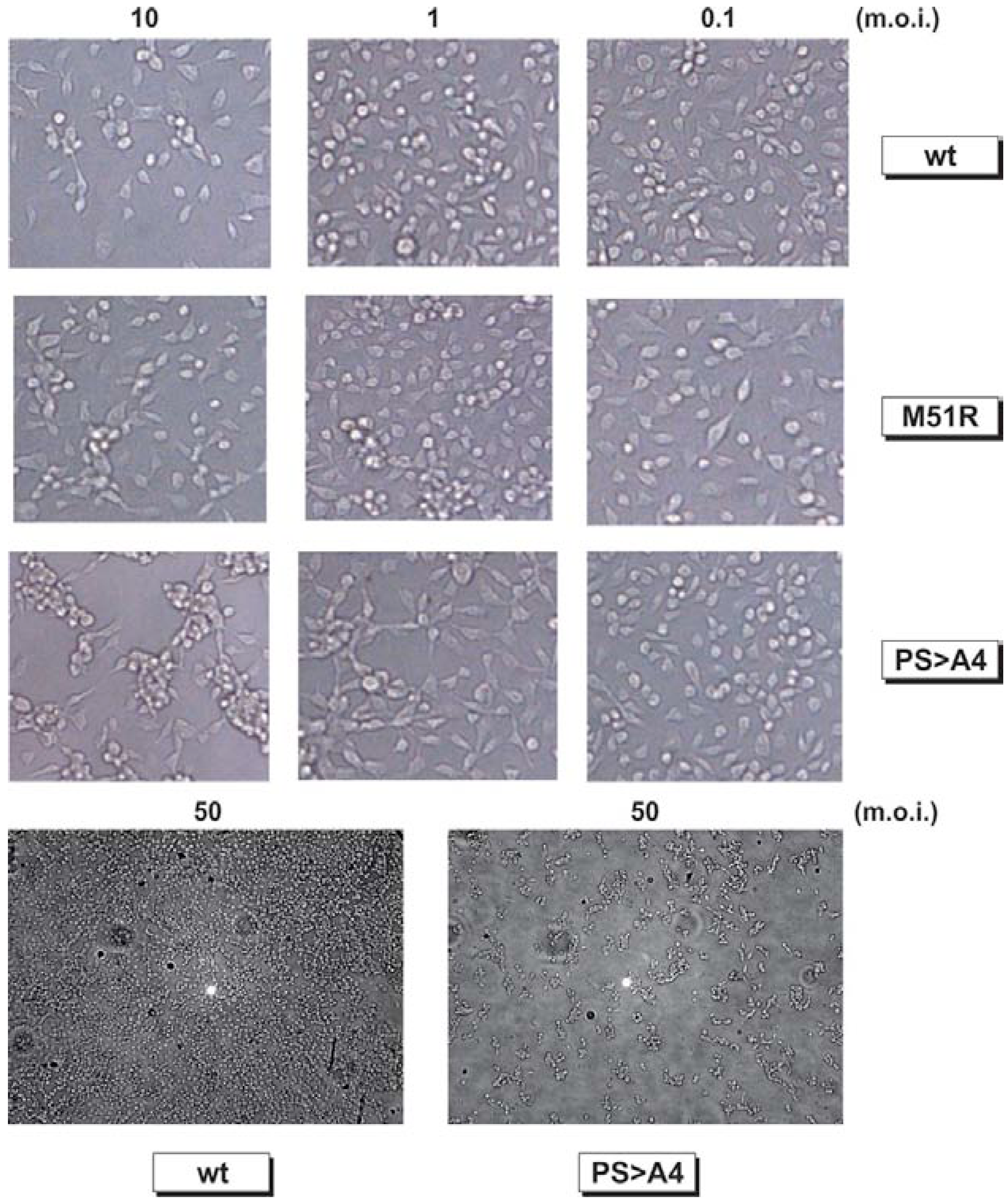
2.3. Virus-Induced Caspase 3 Activity in Mosquito C6/36 Cells
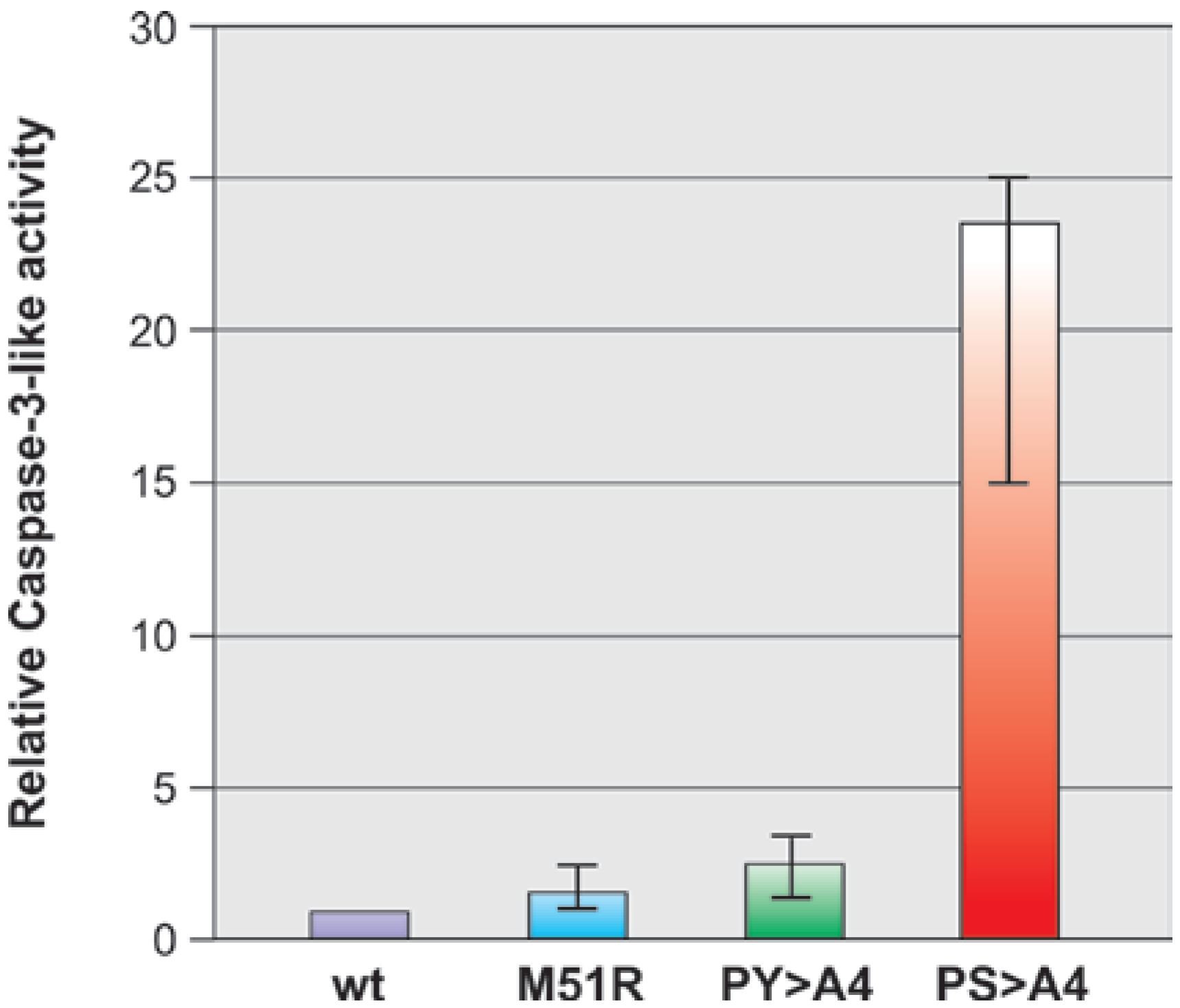
3. Discussion
4. Experimental Section
4.1. Cell and Viruses
4.2. Analysis of Cytopathic Effect and Growth Kinetics of Recombinant Viruses
4.3. Detection of Activated Caspase-3 Activity
4.4. Pathogenicity in Mice
5. Conclusions
Acknowledgements
Conflict of Interest
References and Notes
- Ahmed, M.; Lyles, D.S. Effect of vesicular stomatitis virus matrix protein on transcription directed by host RNA polymerases I, II, and III. J. Virol. 1998, 72, 8413–8419. [Google Scholar]
- Black, B.L.; Lyles, D.S. Vesicular stomatitis virus matrix protein inhibits host cell-directed transcription of target genes in vivo. J. Virol. 1992, 66, 4058–4064. [Google Scholar]
- Connor, J.H.; Lyles, D.S. Inhibition of host and viral translation during vesicular stomatitis virus infection. eIF2 is responsible for the inhibition of viral but not host translation. J. Biol. Chem. 2005, 280, 13512–13519. [Google Scholar] [CrossRef]
- Kopecky, S.A.; Lyles, D.S. The cell-rounding activity of the vesicular stomatitis virus matrix protein is due to the induction of cell death. J. Virol. 2003, 77, 5524–5528. [Google Scholar]
- Kopecky, S.A.; Lyles, D.S. Contrasting effects of matrix protein on apoptosis in HeLa and BHK cells infected with vesicular stomatitis virus are due to inhibition of host gene expression. J. Virol. 2003, 77, 4658–4669. [Google Scholar] [CrossRef]
- Kopecky, S.A.; Willingham, M.C.; Lyles, D.S. Matrix protein and another viral component contribute to induction of apoptosis in cells infected with vesicular stomatitis virus. J. Virol. 2001, 75, 12169–12181. [Google Scholar] [CrossRef]
- Lyles, D.S.; McKenzie, M.O. Activity of vesicular stomatitis virus M protein mutants in cell rounding is correlated with the ability to inhibit host gene expression and is not correlated with virus assembly function. Virology 1997, 229, 77–89. [Google Scholar] [CrossRef]
- Chong, L.D.; Rose, J.K. Membrane association of functional vesicular stomatitis virus matrix protein in vivo. J. Virol. 1993, 67, 407–414. [Google Scholar]
- Craven, R.C.; Harty, R.N.; Paragas, J.; Palese, P.; Wills, J.W. Late domain function identified in the vesicular stomatitis virus M protein by use of rhabdovirus-retrovirus chimeras. J. Virol. 1999, 73, 3359–3365. [Google Scholar]
- Gaudin, Y.; Barge, A.; Ebel, C.; Ruigrok, R.W. Aggregation of VSV M protein is reversible and mediated by nucleation sites: Implications for viral assembly. Virology 1995, 206, 28–37. [Google Scholar] [CrossRef]
- Harty, R.N.; Paragas, J.; Sudol, M.; Palese, P. A proline-rich motif within the matrix protein of vesicular stomatitis virus and rabies virus interacts with WW domains of cellular proteins: Implications for viral budding. J. Virol. 1999, 73, 2921–2929. [Google Scholar]
- Irie, T.; Harty, R.N. L-domain flanking sequences are important for host interactions and efficient budding of vesicular stomatitis virus recombinants. J. Virol. 2005, 79, 12617–12622. [Google Scholar] [CrossRef]
- Jayakar, H.R.; Murti, K.G.; Whitt, M.A. Mutations in the PPPY motif of vesicular stomatitis virus matrix protein reduce virus budding by inhibiting a late step in virion release. J. Virol. 2000, 74, 9818–9827. [Google Scholar] [CrossRef]
- Jayakar, H.R.; Whitt, M.A. Identification of two additional translation products from the matrix (M) gene that contribute to vesicular stomatitis virus cytopathology. J. Virol. 2002, 76, 8011–8018. [Google Scholar] [CrossRef]
- Li, Y.; Luo, L.; Schubert, M.; Wagner, R.R.; Kang, C.Y. Viral liposomes released from insect cells infected with recombinant baculovirus expressing the matrix protein of vesicular stomatitis virus. J. Virol. 1993, 67, 4415–4420. [Google Scholar]
- McCreedy, B.J., Jr.; Lyles, D.S. Distribution of M protein and nucleocapsid protein of vesicular stomatitis virus in infected cell plasma membranes. Virus Res. 1989, 14, 189–205. [Google Scholar] [CrossRef]
- Raux, H.; Obiang, L.; Richard, N.; Harper, F.; Blondel, D.; Gaudin, Y. The matrix protein of vesicular stomatitis virus binds dynamin for efficient viral assembly. J. Virol. 2010, 84, 12609–12618. [Google Scholar] [CrossRef]
- Swinteck, B.D.; Lyles, D.S. Plasma membrane microdomains containing vesicular stomatitis virus M protein are separate from microdomains containing G protein and nucleocapsids. J. Virol. 2008, 82, 5536–5547. [Google Scholar] [CrossRef]
- Taylor, G.M.; Hanson, P.I.; Kielian, M. Ubiquitin depletion and dominant-negative VPS4 inhibit rhabdovirus budding without affecting alphavirus budding. J. Virol. 2007, 81, 13631–13639. [Google Scholar] [CrossRef]
- Gaddy, D.F.; Lyles, D.S. Vesicular stomatitis viruses expressing wild-type or mutant M proteins activate apoptosis through distinct pathways. J. Virol. 2005, 79, 4170–4179. [Google Scholar] [CrossRef]
- Licata, J.M.; Harty, R.N. Rhabdoviruses and apoptosis. Int. Rev. Immunol. 2003, 22, 451–476. [Google Scholar] [CrossRef]
- Blondel, D.; Harmison, G.G.; Schubert, M. Role of matrix protein in cytopathogenesis of vesicular stomatitis virus. J. Virol. 1990, 64, 1716–1725. [Google Scholar]
- Desforges, M.; Charron, J.; Berard, S.; Beausoleil, S.; Stojdl, D.F.; Despars, G.; Laverdiere, B.; Bell, J.C.; Talbot, P.J.; Stanners, C.P.; et al. Different host-cell shutoff strategies related to the matrix protein lead to persistence of vesicular stomatitis virus mutants on fibroblast cells. Virus Res. 2001, 76, 87–102. [Google Scholar] [CrossRef]
- Irie, T.; Carnero, E.; Okumura, A.; Garcia-Sastre, A.; Harty, R.N. Modifications of the PSAP region of the matrix protein lead to attenuation of vesicular stomatitis virus in vitro and in vivo. J. Gen. Virol. 2007, 88, 2559–2567. [Google Scholar] [CrossRef]
- Black, B.L.; Rhodes, R.B.; McKenzie, M.; Lyles, D.S. The role of vesicular stomatitis virus matrix protein in inhibition of host-directed gene expression is genetically separable from its function in virus assembly. J. Virol. 1993, 67, 4814–4821. [Google Scholar]
- Harty, R.N.; Brown, M.E.; McGettigan, J.P.; Wang, G.; Jayakar, H.R.; Huibregtse, J.M.; Whitt, M.A.; Schnell, M.J. Rhabdoviruses and the cellular ubiquitin-proteasome system: A budding interaction. J. Virol. 2001, 75, 10623–10629. [Google Scholar]
- Irie, T.; Licata, J.M.; Jayakar, H.R.; Whitt, M.A.; Bell, P.; Harty, R.N. Functional analysis of late-budding domain activity associated with the PSAP motif within the vesicular stomatitis virus M protein. J. Virol. 2004, 78, 7823–7827. [Google Scholar] [CrossRef]
- Irie, T.; Licata, J.M.; McGettigan, J.P.; Schnell, M.J.; Harty, R.N. Budding of PPxY-containing rhabdoviruses is not dependent on host proteins TGS101 and VPS4A. J. Virol. 2004, 78, 2657–2665. [Google Scholar] [CrossRef]
- Lichty, B.D.; McBride, H.; Hanson, S.; Bell, J.C. Matrix protein of Vesicular stomatitis virus harbours a cryptic mitochondrial-targeting motif. J. Gen. Virol. 2006, 87, 3379–3384. [Google Scholar] [CrossRef]
- Mire, C.E.; Whitt, M.A. The protease-sensitive loop of the vesicular stomatitis virus matrix protein is involved in virus assembly and protein translation. Virology 2011, 416, 16–25. [Google Scholar] [CrossRef]
- Obiang, L.; Raux, H.; Ouldali, M.; Blondel, D.; Gaudin, Y. Phenotypes of vesicular stomatitis virus mutants with mutations in the PSAP motif of the matrix protein. J. Gen. Virol. 2012, 93, 857–865. [Google Scholar] [CrossRef]
- Publicover, J.; Ramsburg, E.; Robek, M.; Rose, J.K. Rapid pathogenesis induced by a vesicular stomatitis virus matrix protein mutant: Viral pathogenesis is linked to induction of tumor necrosis factor alpha. J. Virol. 2006, 80, 7028–7036. [Google Scholar] [CrossRef]
- Ahmed, M.; McKenzie, M.O.; Puckett, S.; Hojnacki, M.; Poliquin, L.; Lyles, D.S. Ability of the matrix protein of vesicular stomatitis virus to suppress beta interferon gene expression is genetically correlated with the inhibition of host RNA and protein synthesis. J. Virol. 2003, 77, 4646–4657. [Google Scholar]
- Fang, X.; Zhang, S.; Sun, X.; Li, J.; Sun, T. Evaluation of attenuated VSVs with mutated M or/and G proteins as vaccine vectors. Vaccine 2012, 30, 1313–1321. [Google Scholar] [CrossRef]
- Kim, G.N.; Kang, C.Y. Matrix protein of VSV New Jersey serotype containing methionine to arginine substitutions at positions 48 and 51 allows near-normal host cell gene expression. Virology 2007, 357, 41–53. [Google Scholar] [CrossRef]
- Lyles, D.S. Cytopathogenesis and inhibition of host gene expression by RNA viruses. Microbiol. Mol. Biol. Rev. 2000, 64, 709–724. [Google Scholar] [CrossRef]
- Lopez-Herrera, A.; Ruiz-Saenz, J.; Goez, Y.P.; Zapata, W.; Velilla, P.A.; Arango, A.E.; Urcuqui-Inchima, S. Apoptosis as pathogenic mechanism of infection with vesicular stomatitis virus. Evidence in primary bovine fibroblast cultures. Biocell 2009, 33, 121–132. [Google Scholar]
- Desforges, M.; Despars, G.; Berard, S.; Gosselin, M.; McKenzie, M.O.; Lyles, D.S.; Talbot, P.J.; Poliquin, L. Matrix protein mutations contribute to inefficient induction of apoptosis leading to persistent infection of human neural cells by vesicular stomatitis virus. Virology 2002, 295, 63–73. [Google Scholar] [CrossRef]
- Drolet, B.S.; Campbell, C.L.; Stuart, M.A.; Wilson, W.C. Vector competence of Culicoides sonorensis (Diptera: Ceratopogonidae) for vesicular stomatitis virus. J. Med. Entomol. 2005, 42, 409–418. [Google Scholar] [CrossRef]
© 2012 by the authors; licensee MDPI, Basel, Switzerland. This article is an open-access article distributed under the terms and conditions of the Creative Commons Attribution license (http://creativecommons.org/licenses/by/3.0/).
Share and Cite
Irie, T.; Liu, Y.; Drolet, B.S.; Carnero, E.; García-Sastre, A.; Harty, R.N. Cytopathogenesis of Vesicular Stomatitis Virus Is Regulated by the PSAP Motif of M Protein in a Species-Dependent Manner. Viruses 2012, 4, 1605-1618. https://doi.org/10.3390/v4091605
Irie T, Liu Y, Drolet BS, Carnero E, García-Sastre A, Harty RN. Cytopathogenesis of Vesicular Stomatitis Virus Is Regulated by the PSAP Motif of M Protein in a Species-Dependent Manner. Viruses. 2012; 4(9):1605-1618. https://doi.org/10.3390/v4091605
Chicago/Turabian StyleIrie, Takashi, Yuliang Liu, Barbara S. Drolet, Elena Carnero, Adolfo García-Sastre, and Ronald N. Harty. 2012. "Cytopathogenesis of Vesicular Stomatitis Virus Is Regulated by the PSAP Motif of M Protein in a Species-Dependent Manner" Viruses 4, no. 9: 1605-1618. https://doi.org/10.3390/v4091605
APA StyleIrie, T., Liu, Y., Drolet, B. S., Carnero, E., García-Sastre, A., & Harty, R. N. (2012). Cytopathogenesis of Vesicular Stomatitis Virus Is Regulated by the PSAP Motif of M Protein in a Species-Dependent Manner. Viruses, 4(9), 1605-1618. https://doi.org/10.3390/v4091605





